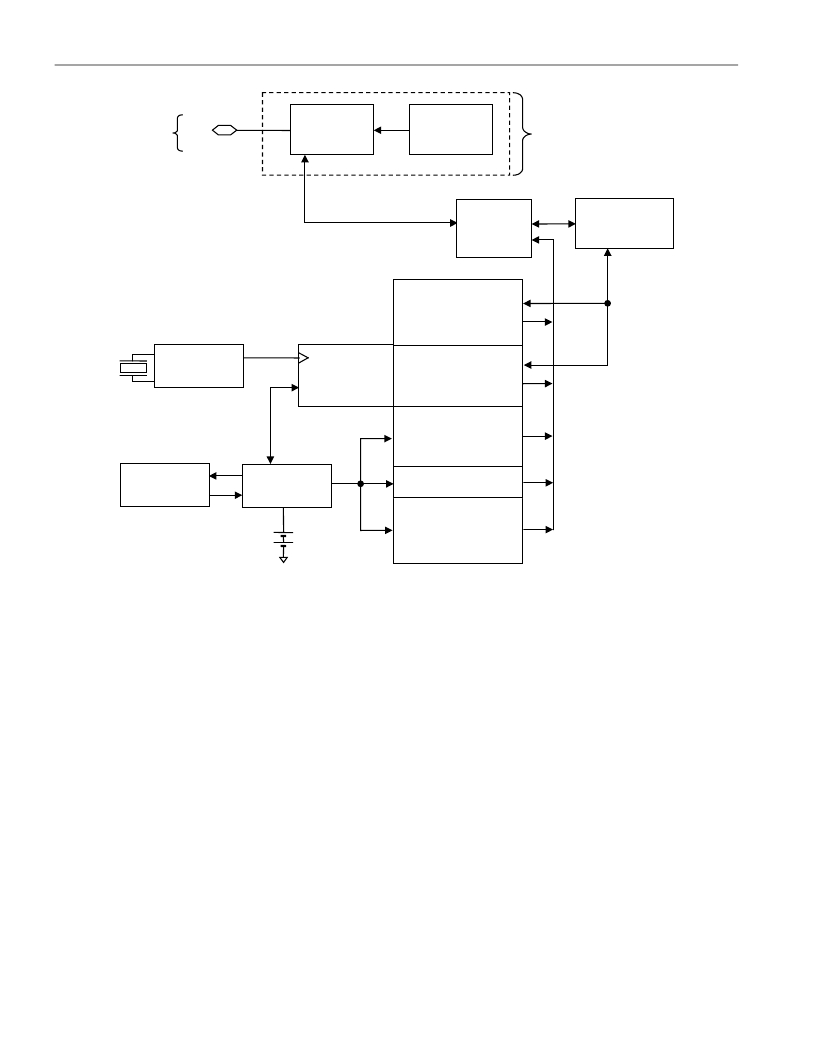- 您现在的位置:买卖IC网 > Sheet目录221 > DS1921H-F5# (Maxim Integrated)IBUTTON THERMOCHRON F5
�� �
�
 �
�DS1921H/Z� BLOCK� DIAGRAM� Figure� 1�
�DS1921H/Z�
�1-Wire�
�Port�
�IO�
�ROM�
�Function�
�Control�
�64-Bit�
�Lasered�
�ROM�
�Parasite�
�Powered�
�Circuitry�
�Memory�
�Function�
�Control�
�General-Purpose�
�SRAM�
�256-Bit�
�Scratchpad�
�32.768kHz�
�Oscillator�
�Temperature�
�Sensor�
�3V� Lithium�
�Control�
�Logic�
�Internal�
�Timekeeping� &�
�Control� Reg.� &�
�Counters�
�Register� Page�
�Alarm� Time� Stamp�
�and� Duration�
�Logging� Memory�
�Histogram� Memory�
�Datalog�
�Memory�
�PARASITE� POWER�
�The� block� diagram� (Figure� 1)� shows� the� parasite-powered� circuitry.� This� circuitry� “steals”� power�
�whenever� the� IO� input� is� high.� IO� will� provide� sufficient� power� as� long� as� the� specified� timing� and�
�voltage� requirements� are� met.� The� advantages� of� parasite� power� are� two-fold:� 1)� By� parasiting� off� this�
�input,� battery� power� is� not� consumed� for� 1-Wire� ROM� function� commands,� and� 2)� if� the� battery� is�
�exhausted� for� any� reason,� the� ROM� may� still� be� read� normally.� The� remaining� circuitry� of� the� DS1921� is�
�solely� operated� by� battery� energy.� As� a� consequence,� if� the� battery� is� exhausted,� all� memory� data� is� lost�
�including� the� data� of� the� last� mission,� and� no� new� mission� can� be� started.� Application� Note� 5057:�
�OneWireViewer� Tips� and� Tricks� explains� how� to� check� the� battery� status.�
�64-BIT� LASERED� ROM�
�Each� DS1921� contains� a� unique� ROM� code� that� is� 64� bits� long.� The� first� eight� bits� are� a� 1-Wire� family�
�code.� The� next� 36� bits� are� a� unique� serial� number.� The� next� 12� bits,� called� temperature� range� code,� allow�
�distinguishing� the� DS1921H� and� DS1921Z� from� each� other� and� from� other� DS1921� versions.� The� last�
�eight� bits� are� a� CRC� of� the� first� 56� bits.� See� Figure� 3� for� details.� The� 1-Wire� CRC� is� generated� using� a�
�polynomial� generator� consisting� of� a� shift� register� and� XOR� gates� as� shown� in� Figure� 4.� The� polynomial�
�is� X� 8� +� X� 5� +� X� 4� +� 1.� Additional� information� about� the� Maxim� 1-Wire� Cyclic� Redundancy� Check� is�
�available� in� Application� Note� 27.�
�The� shift� register� bits� are� initialized� to� 0.� Then� starting� with� the� least� significant� bit� of� the� family� code,�
�one� bit� at� a� time� is� shifted� in.� After� the� eighth� bit� of� the� family� code� has� been� entered,� then� the� serial�
�number� followed� by� the� temperature� range� code� is� entered.� After� the� range� code� has� been� entered,� the�
�shift� register� contains� the� CRC� value.� Shifting� in� the� eight� bits� of� CRC� returns� the� shift� register� to� all� 0s.�
�3� of� 45�
�发布紧急采购,3分钟左右您将得到回复。
相关PDF资料
DS1921K#
KIT IBUTTON THERMOCHRON
DS1922E-F5#
IBUTTON TEMP LOGGER 4KBit F5
DS1922L-F5#
IBUTTON TEMP LOGGER
DS1923-F5#
IBUTTON TEMP/HUMIDITY LOGGER F5
DS1961S-F3#
IBUTTON EEPROM 1KBit F3
DS1963S-F5+
IBUTTON MONETARY SHA-1
DS1971-F3+
IBUTTON EEPROM 256KBIT F3
DS1972-F3+
IBUTTON EEPROM 1KBit F3
相关代理商/技术参数
DS1921H-F5/A1C
功能描述:iButton
RoHS:否 存储类型:SRAM 存储容量:512 B 组织: 工作电源电压:3 V to 5.25 V 接口类型:1-Wire 最大工作温度:+ 85 C 尺寸:17.35 mm x 5.89 mm 封装 / 箱体:F5 MicroCan 制造商:Maxim Integrated
DS1921H-F5+A1C
功能描述:iButton
RoHS:否 存储类型:SRAM 存储容量:512 B 组织: 工作电源电压:3 V to 5.25 V 接口类型:1-Wire 最大工作温度:+ 85 C 尺寸:17.35 mm x 5.89 mm 封装 / 箱体:F5 MicroCan 制造商:Maxim Integrated
DS1921H-F50
功能描述:iButton RoHS:否 存储类型:SRAM 存储容量:512 B 组织: 工作电源电压:3 V to 5.25 V 接口类型:1-Wire 最大工作温度:+ 85 C 尺寸:17.35 mm x 5.89 mm 封装 / 箱体:F5 MicroCan 制造商:Maxim Integrated
DS1921K
功能描述:存储器 IC 开发工具 RoHS:否 制造商:STMicroelectronics 产品:Reference Boards 工具用于评估:M24LR64-R 存储容量:64 kbit 存储类型:EEPROM 工作电源电压:1.8 V to 5.5 V
DS1921K#
功能描述:温度传感器开发工具 Thermochron iButton Kit RoHS:否 制造商:Texas Instruments 产品类型:Temperature Sensors and Control ICs 工具用于评估:MSP430G2553 接口类型:USB 工作电源电压: 工作电源电流:
DS1921L-F50
制造商:DALLAS 制造商全称:Dallas Semiconductor 功能描述:Thermochron iButton
DS1921L-F51
制造商:DALLAS 制造商全称:Dallas Semiconductor 功能描述:Thermochron iButton
DS1921L-F52
制造商:DALLAS 制造商全称:Dallas Semiconductor 功能描述:Thermochron iButton